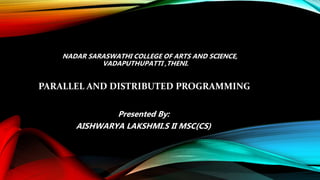
cloud computing.pptx
- 1. NADAR SARASWATHI COLLEGE OF ARTS AND SCIENCE, VADAPUTHUPATTI ,THENI. PARALLEL AND DISTRIBUTED PROGRAMMING Presented By: AISHWARYA LAKSHMI.S II MSC(CS)
- 2. ABOUT PARALLEL COMPUTING AND DISTRIBUTED COMPUTING There are mainly two computation types, including parallel computing and distributed computing. • A computer system may perform tasks according to human instructions. A single processor executes only one task in the computer system, which is not an effective way. • Parallel computing solves this problem by allowing numerous processors to accomplish tasks simultaneously. Modern computers support parallel processing to improve system performance.
- 3. ABOUT PARALLEL COMPUTING AND DISTRIBUTED COMPUTING • In contrast, distributed computing enables several computers to communicate with one another and achieve a goal. • All of these computers communicate and collaborate over the network. Distributed computing is commonly used by organizations such as Facebook and Google that allow people to share resources.
- 4. WHAT IS PARALLEL COMPUTING? • It is also known as parallel processing. It utilizes several processors. Each of the processors completes the tasks that have been allocated to them. • In other words, parallel computing involves performing numerous tasks simultaneously. • A shared memory or distributed memory system can be used to assist in parallel computing. • All CPUs in shared memory systems share the memory.
- 5. WHAT IS PARALLEL COMPUTING? • Memory is shared between the processors in distributed memory systems. • Parallel computing provides numerous advantages. • Parallel computing helps to increase the CPU utilization and improve the performance because several processors work simultaneously. • Moreover, the failure of one CPU has no impact on the other CPUs' functionality. • Furthermore, if one processor needs instructions from another, the CPU might cause latency.
- 6. ADVANTAGES AND DISADVANTAGES OF PARALLEL COMPUTING • There are various advantages and disadvantages of parallel computing. Some of the advantages and disadvantages are as follows: Advantages 1.It saves time and money because many resources working together cut down on time and costs. 2.It may be difficult to resolve larger problems on Serial Computing. 3.You can do many things at once using many computing resources. 4.Parallel computing is much better than serial computing for modeling, simulating, and comprehending complicated real-world events .oncusing many computing resources. 5.Parallel computing is much better than serial computing for modeling, simulating, and comprehending complicated real-world events.
- 7. ADVANTAGES AND DISADVANTAGES OF PARALLEL COMPUTING Disadvantages 1.The multi-core architectures consume a lot of power. 2.Parallel solutions are more difficult to implement, debug, and prove right due to the complexity of communication and coordination, and they frequently perform worse than their serial equivalents.
- 8. KEY DIFFERENCES BETWEEN THE PARALLEL COMPUTING AND DISTRIBUTED COMPUTING Here, you will learn the various key differences between parallel computing and distributed computation. Some of the key differences between parallel computing and distributed computing are as follows: 1.Parallel computing is a sort of computation in which various tasks or processes are run at the same time. In contrast, distributed computing is that type of computing in which the components are located on various networked systems that interact and coordinate their actions by passing messages to one another. 2.In parallel computing, processors communicate with another processor via a bus. On the other hand, computer systems in distributed computing connect with one another via a network. 3.Parallel computing takes place on a single computer. In contrast, distributed computing takes place on several computers.
- 9. KEY DIFFERENCES BETWEEN THE PARALLEL COMPUTING AND DISTRIBUTED COMPUTING 4.Parallel computing aids in improving system performance. On the other hand, distributed computing allows for scalability, resource sharing, and the efficient completion of computation tasks 5.The computer in parallel computing can have shared or distributed memory. In contrast, every system in distributed computing has its memory. 6.Multiple processors execute multiple tasks simultaneously in parallel computing. In contrast, many computer systems execute tasks simultaneously in distributed computing.
- 10. CONCLUSION There are two types of computations: parallel computing and distributed computing. Parallel computing allows several processors to accomplish their tasks at the same time. In contrast, distributed computing splits a single task among numerous systems to achieve a common goal.
- 11. THANK YOU!!!